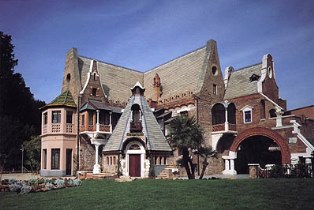
WTI Magazine #33 2014 June, 4
Author : Enrico De Iulis Translation by:
Villa Torlonia in Rome is one of the most interesting parks in the capital. The garden extends behind the right side of Via Nomentana and belonged to one of the most important families of the eighteenth and nineteenth-century Roman landscape.
The Torlonia princes were able, thanks to few very important marriages, to acquire an impressive collection of ancient statues and archaeological findings, owning dozens of plots of land around the city and almost always in the vicinity of the consular roads, with the obvious result of archaeological findings as soon as they stirred the soil of those fields.
The Prince Alessandro Torlonia wanted to have a residence which would celebrate the archaeological taste that had always characterized his family, and so Giuseppe Valadier, one of the most talented neoclassical architects in the Rome of the early part of the nineteenth century, built a residence that still today remains superlative in the purity and elegance of its form.
The combination of neo-classical statues is a clear winner for consistency and homogeneity, but Villa Torlonia was not limited to being merely a container of style, it did not remained anchored to the taste of the first footprint of the building.
Along with the main body of the park and its faux classic ruins that form a natural backdrop to the real archaeological findings, located in the beautiful Italian garden, there are other equally interesting buildings that only in recent years have been beautifully restored, enhancing the entire area.
The "Casina delle Civette" (House of the Owls) was the first to be restored with an incredible success: it is a liberty style cottage that saw the works of the greatest exponents of the Roman school of arts and crafts as Duilio Cambellotti, Paolo Paschetto and Vittorio Grassi, whose inventions are grafted in the architecture of Vincenzo Fasolo. The Casina was the residence of Prince Alessandro Torlonia Jr. until his death in 1936, having been practically "evicted" by Benito Mussolini, who wanted for him the primary residence.
If the "Casino Nobile" houses the collection of the Roman School of the twentieth century, and the museum spaces are about the history of the villa itself, the Casina delle Civette is a place of exhibitions on the themes of ceramic, glass and applied arts typical of the past three centuries.
The "Casino dei Principi" instead, has a XVI century aspect, found after a strong adaptation of G.B. Caretti in the 30s of the XIX century. It now houses the monographic exhibitions of the protagonists of the applied arts most active in Rome in the XIX century and into the XX century.
The stables are now a neoclassical senior center, while the "lemonaia" deco features a restaurant. The last grand opening happened a few weeks ago: the Torlonia theater, a building of glass, cast iron and marble that is very reminiscent of the buildings of the early XX century in Paris or London.
Very soon there will also be the reopening of the last remaining building still under restoration: the Moorish Serra, a place which will be dedicated to events related to botany and floriculture.
Villa Torlonia unfairly does not fall within the places of art that take precedence in visiting Rome, but it really is a place that makes you perfectly understand the Roman cultural climate of the last two hundred years.



